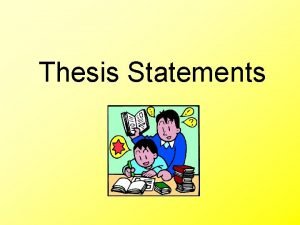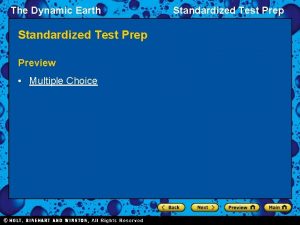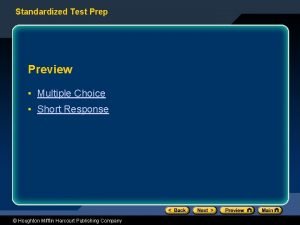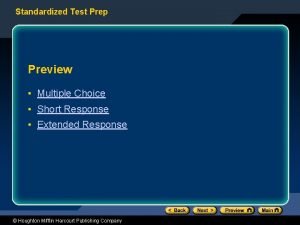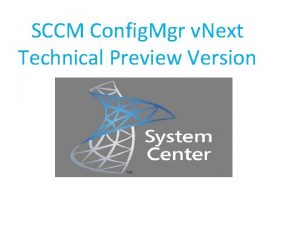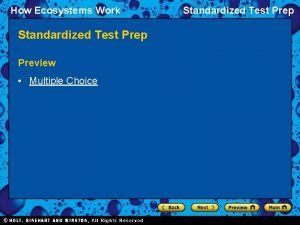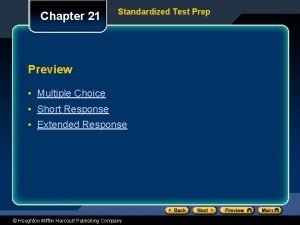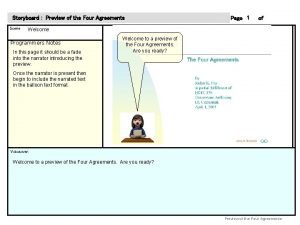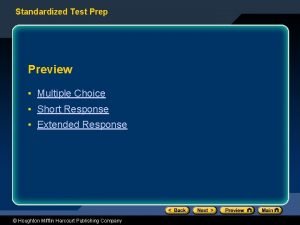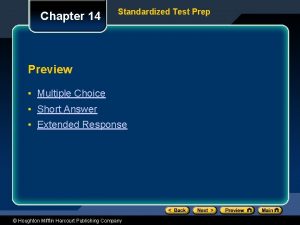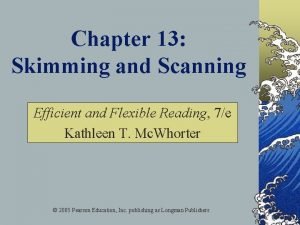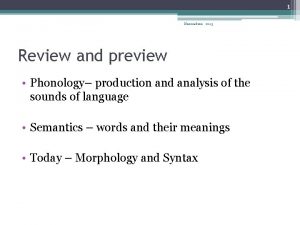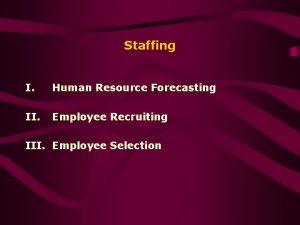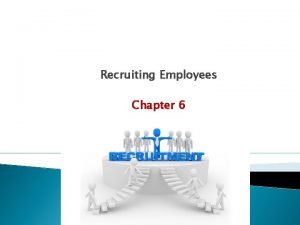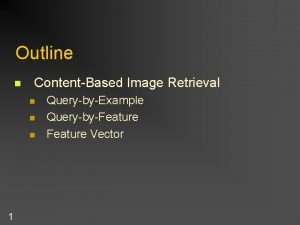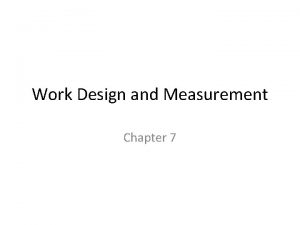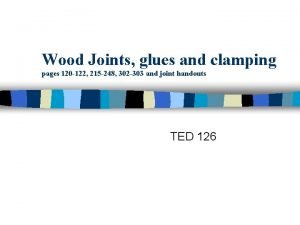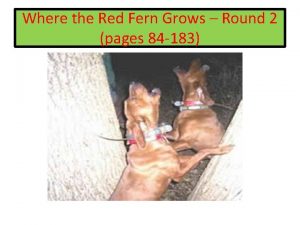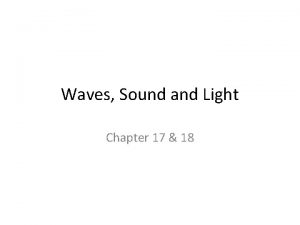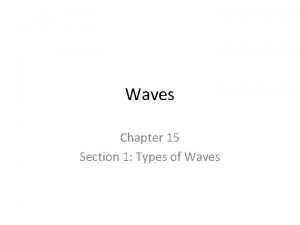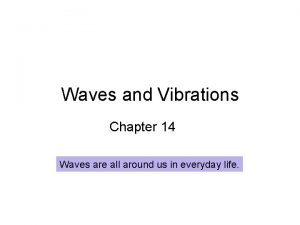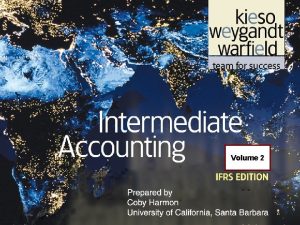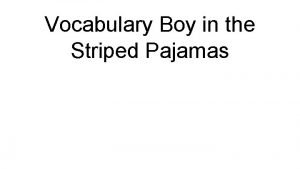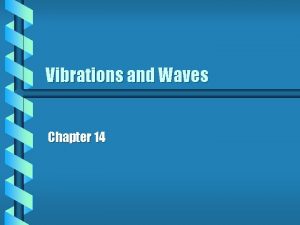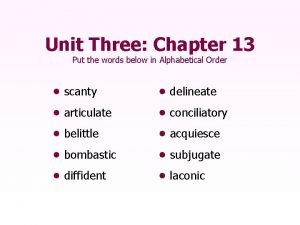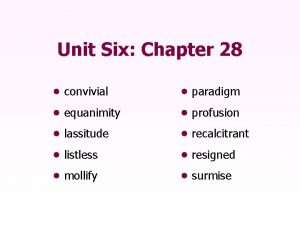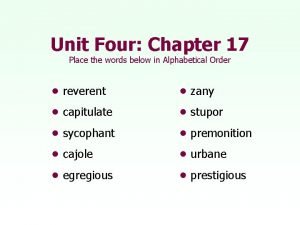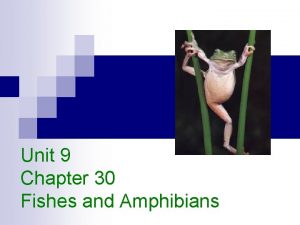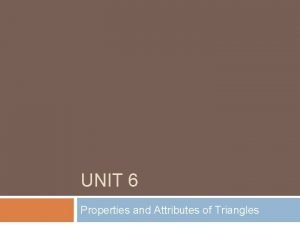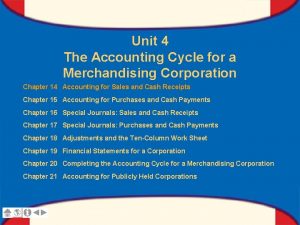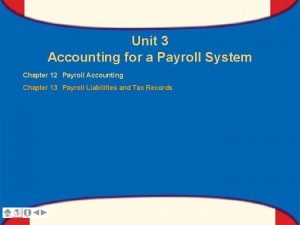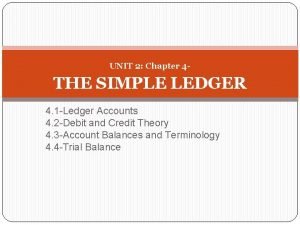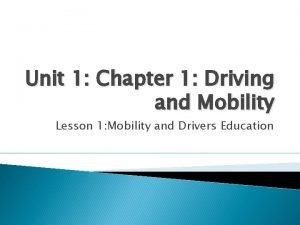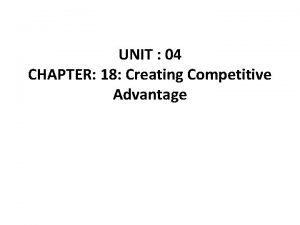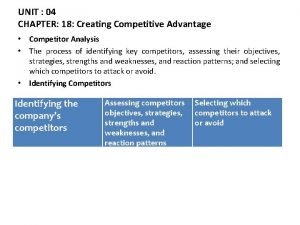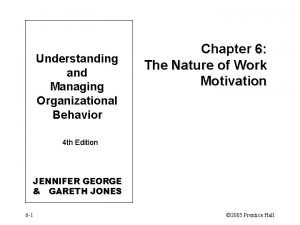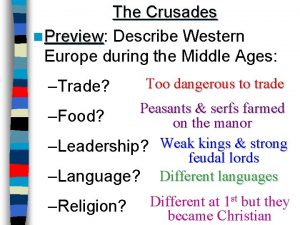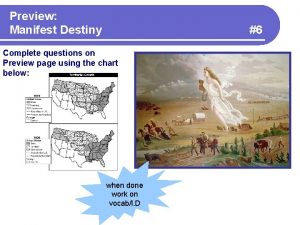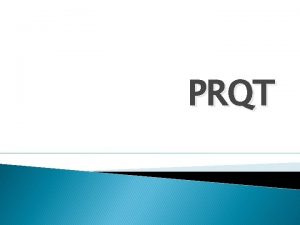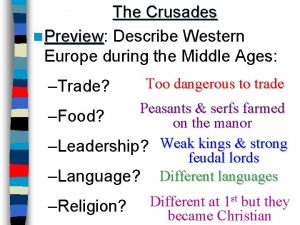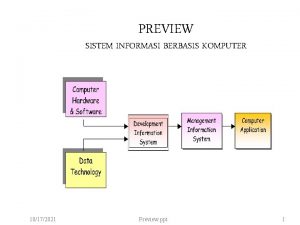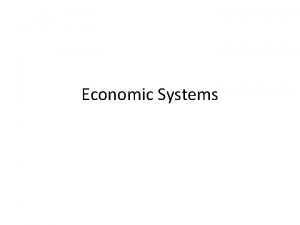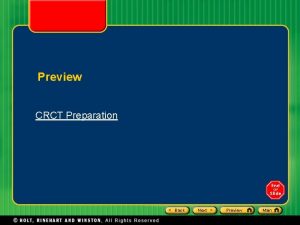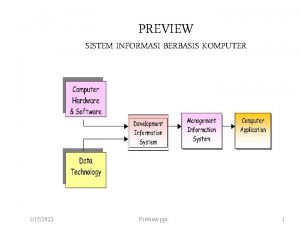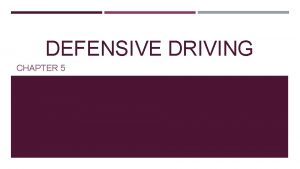17 1 PREVIEW OF CHAPTER 17 17 2
































































































































- Slides: 128

17 -1

PREVIEW OF CHAPTER 17 17 -2 Intermediate Accounting 16 th Edition Kieso ● Weygandt ● Warfield

17 Investments LEARNING OBJECTIVES After studying this chapter, you should be able to: 17 -3 1 Understand the accounting for investments in debt securities. 3 Explain the equity and consolidation methods of accounting. 2 Understand the accounting for investments in equity securities. 4 Evaluate other major issues related to investments in debt and equity securities. LO 1

INVESTMENT IN DEBT SECURITIES Different motivations for investing: 17 -4 u To earn a high rate of return. u To secure certain operating or financing arrangements with another company. LO 1

INVESTMENT IN DEBT SECURITIES Companies account for investments based on u the type of security (debt or equity) and u their intent with respect to the investment. ILLUSTRATION 17 -1 Summary of Investment Accounting Approaches 17 -5 LO 1

Debt Investment Classifications Debt securities represent a creditor relationship: Type u 17 -6 U. S. government securities u Municipal securities u Corporate bonds u Convertible debt u Commercial paper Accounting Category u Held-to-maturity u Trading u Available-for-sale LO 1

Debt Investment Classifications Amortized cost is the acquisition cost adjusted for the amortization of discount or premium, if appropriate. 17 -7 ILLUSTRATION 17 -2 Accounting for Debt Securities by Category LO 1

INVESTMENT IN DEBT SECURITIES Held-to-Maturity Securities (Amortized Cost) Classify a debt security as held-to-maturity only if it has both 1) the positive intent and 2) the ability to hold securities to maturity. Accounted for at amortized cost, not fair value. Amortize premium or discount using the effective-interest method unless the straight-line method yields a similar result. 17 -8 LO 1

Held-to-Maturity Securities (Amortized Cost) Illustration: Z-Smith Company purchased $100, 000 of 8 percent bonds of Bush Corporation on January 1, 2016, at a discount, paying $92, 278. The bonds mature January 1, 2021 and yield 10%; interest is payable each July 1 and January 1. Z-Smith records the investment as follows: January 1, 2016 Debt Investments Cash 17 -9 92, 278 LO 1

ILLUSTRATION 17 -3 Schedule of Interest Revenue and Bond Discount Amortization— Effective-Interest Method 17 -10 LO 1

ILLUSTRATION 17 -3 Illustration: Z-Smith Company records the receipt of the first semiannual interest payment on July 1, 2016, as follows: Cash 4, 000 Debt Investments 614 Interest Revenue 17 -11 4, 614 LO 1

ILLUSTRATION 17 -3 Illustration: Z-Smith is on a calendar-year basis, it accrues interest and amortizes the discount at December 31, 2016, as follows: Interest Receivable 4, 000 Debt Investments 645 Interest Revenue 17 -12 4, 645 LO 1

Held-to-Maturity Securities (Amortized Cost) Reporting of Held-to-Maturity Securities ILLUSTRATION 17 -4 Reporting of Held-to-Maturity Securities 17 -13 LO 1

Held-to-Maturity Securities (Amortized Cost) ILLUSTRATION 17 -3 Illustration: Assume Z-Smith sells its investment in Bush bonds on November 1, 2020, at 99¾ plus accrued interest. Z-Smith records discount amortization as follows: 17 -14 Calculation of amortization = $952 x 4/6 = $635 Debt Investments 635 Interest Revenue 635 LO 1

Held-to-Maturity Securities (Amortized Cost) Computation of Gain on Sale of Bonds Cash ILLUSTRATION 17 -5 102, 417 Interest Revenue (4/6 x $4, 000) Debt Investments Gain on Sale of Securities 17 -15 2, 667 99, 683 67 LO 1

INVESTMENT IN DEBT SECURITIES Available-for-Sale Securities Companies report available-for-sale securities at u fair value, with u unrealized holding gains and losses reported as other comprehensive income, a separate component of stockholder’s equity, until realized. Any discount or premium is amortized. 17 -16 LO 1

Available-for-Sale Securities Debt Securities Illustration (Single Security): Graffeo Corporation purchases $100, 000, 10 percent, five-year bonds on January 1, 2016, with interest payable on July 1 and January 1. The bonds sell for $108, 111, which results in a bond premium of $8, 111 and an effective interest rate of 8 percent. Graffeo records the purchase of the bonds on January 1, 2016, as follows. Debt Investments Cash 17 -17 108, 111 LO 1

ILLUSTRATION 17 -6 Schedule of Interest Revenue and Bond Premium Amortization— Effective-Interest Method 17 -18 LO 1

ILLUSTRATION 17 -6 Illustration (Single Security): The entry to record interest revenue on July 1, 2016, is as follows. Cash 17 -19 5, 000 Debt Investments 676 Interest Revenue 4, 324 LO 1

Debt Securities Available-for-Sale Securities Interest Revenue for 2016 = $8, 621 ILLUSTRATION 17 -6 Illustration (Single Security): At December 31, 2016, Graffeo makes the following entry to recognize interest revenue. Interest Receivable 17 -20 5, 000 Debt Investments 703 Interest Revenue 4, 297 LO 1

Debt Securities Available-for-Sale Securities ILLUSTRATION 17 -6 Illustration (Single Security): To apply the fair value method to these debt securities, assume that at December 31, 2016 the fair value of the bonds is $105, 000. Graffeo makes the following entry. Unrealized Holding Gain or Loss—Equity Fair Value Adjustment 17 -21 1, 732 LO 1

Available-for-Sale Securities Debt Securities Illustration (Portfolio of Securities): Herringshaw Corporation has two debt securities classified as available-for-sale. The following illustration identifies the amortized cost, fair value, and the amount of the unrealized gain or loss. 17 -22 ILLUSTRATION 17 -7 Computation of Fair Value Adjustment—Available-for-Sale Securities (2017) LO 1

Debt Securities Available-for-Sale Securities ILLUSTRATION 17 -7 Prepare the adjusting entry Herringshaw would make on December 31, 2017 to record the loss. Unrealized Holding Gain or Loss—Equity Fair Value Adjustment 17 -23 9, 537 LO 1

Available-for-Sale Securities Debt Securities Sale of Available-for-Sale Securities If company sells bonds before maturity date: 17 -24 u It must make entries to remove from the Debt Investments account the amortized cost of bonds sold. u Any realized gain or loss on sale is reported in the “Other” section of the income statement. LO 1

Sale of Available-for-Sale Securities Illustration: Herringshaw Corporation sold the Watson bonds (from Illustration 17 -7) on July 1, 2018, for $90, 000, at which time it had an amortized cost of $94, 214. ILLUSTRATION 17 -8 Computation of Loss on Sale of Bonds Cash 90, 000 Loss on Sale of Investments Debt Investments 17 -25 4, 214 94, 214 LO 1

Sale of Available-for-Sale Securities Illustration: Herringshaw reports this realized loss in the “Other expenses and losses” section of the income statement. Assuming no other purchases and sales of bonds in 2018, Herringshaw on December 31, 2018, prepares the information: ILLUSTRATION 17 -9 Computation of Fair Value Adjustment—Available-for-Sale Securities (2018) 17 -26 LO 1

Sale of Available-for-Sale Securities Illustration: Herringshaw records the following at December 31, 2018. ILLUSTRATION 17 -9 Fair Value Adjustment 4, 537 Unrealized Holding Gain or Loss—Equity 17 -27 4, 537 LO 1

Available-for-Sale Securities Financial Statement Presentation 17 -28 Debt Securities ILLUSTRATION 17 -10 Reporting of Available-for. Sale Securities LO 1

INVESTMENT IN DEBT SECURITIES Trading Securities (Fair Value Through Net Income) Companies report trading securities at u fair value, with u unrealized holding gains and losses reported as part of net income. Any discount or premium is amortized. A holding gain or loss is the net change in the fair value of a security from one period to another, exclusive of dividend or interest revenue recognized but not received. 17 -29 LO 1

Trading Securities Debt Securities Illustration: On December 31, 2017, Koopmans Publishing Corporation determined its trading securities portfolio to be as follows: ILLUSTRATION 17 -11 Computation of Fair Value Adjustment—Trading Securities Portfolio (2017) 17 -30 LO 1

Trading Securities Debt Securities Illustration: At December 31, Koopmans Publishing makes an adjusting entry: ILLUSTRATION 17 -11 Fair Value Adjustment 3, 750 Unrealized Holding Gain or Loss—Income 17 -31 3, 750 LO 1

Trading Securities Debt Securities Illustration: (Trading Securities) Hendricks Corporation purchased trading investment bonds for $50, 000 at par. At December 31, Hendricks received annual interest of $2, 000, and the fair value of the bonds was $47, 400. Instructions: 17 -32 a) Prepare the journal entry for the purchase of the investment. b) Prepare the journal entry for the interest received. c) Prepare the journal entry for the fair value adjustment. LO 1

Debt Securities Trading Securities Illustration: (Trading Securities) Hendricks Corporation purchased trading investment bonds for $50, 000 at par. At December 31, Hendricks received annual interest of $2, 000, and the fair value of the bonds was $47, 400. Prepare the journal entry for the purchase of the investment. Debt Investments Cash 17 -33 50, 000 LO 1

Debt Securities Trading Securities Illustration: (Trading Securities) Hendricks Corporation purchased trading investment bonds for $50, 000 at par. At December 31, Hendricks received annual interest of $2, 000, and the fair value of the bonds was $47, 400. Prepare the journal entry for the interest received. Cash Interest Revenue 17 -34 2, 000 LO 1

Debt Securities Trading Securities Illustration: (Trading Securities) Hendricks Corporation purchased trading investment bonds for $50, 000 at par. At December 31, Hendricks received annual interest of $2, 000, and the fair value of the bonds was $47, 400. Prepare the journal entry for the fair value adjustment. Unrealized Holding Loss – Income Fair Value Adjustment 17 -35 2, 600 LO 1

WHAT DO THE NUMBERS MEAN? WHAT’S TO YOUR HAVE AND TO HOLD PRINCIPLE Wall Street is a romantic place these days. Recently, many banks, especially big ones, entered into long-term relationships with their securities portfolios, promising that hundreds of billions of dollars of assets will be “held-to-maturity. ” As a result, the banks may appear to have higher book values and be better capitalized in the eyes of regulators even if the value of these securities declines. In fact, many banks, especially the large ones, have recently shifted their debt investments portfolios into the “held-to-maturity” category from trading or available-for-sale. For example, in a recent 18 -month period, banks have moved $293 billion of their investments to the held-to-maturity category. That means that about $640 billion, or one in five dollars in the banks’ portfolios, cannot be sold easily, as shown in the chart to the right. 17 -36 (continued) LO 1

WHAT DO THE NUMBERS MEAN? WHAT’S TO YOUR HAVE AND TO HOLD PRINCIPLE Why the shift? One major reason is that banks recognize when securities are classified as held-to-maturity, they are carried at their original cost, typically face value. As you have learned, declines in market values hit neither book value nor earnings. Their value is written down only if they are considered to be permanently impaired. If long-term interest rates are expected to rise (which appears to be the consensus today), then bond prices will drop. And if bond prices drop, banks that hold trading or available-for-sale securities will have their earnings and capital drop. As a result, the shift to held-to-maturity portfolios provides protection from this level of volatility. But banks should be careful. For example, if the bank has liquidity problems, it may have to sell these held-to-maturity securities for a large loss at inopportune times. And given the financial crisis of 2008, the process of trying to hype capital and maintain less volatile earnings may backfire if investors believe that shenanigans are taking place in the financial institution area. Sources: John Carney, “Accounting Trick Can Help Banks Dodge Some Capital Pain, ” Wall Street Journal (March 28, 2014); and Michael Rapoport, “Banks Shift Bond Portfolios, ” Wall Street Journal (March 23, 2015). 17 -37 LO 1

17 Investments LEARNING OBJECTIVES After studying this chapter, you should be able to: 1 Understand the accounting for investments in debt securities. 2 Understand the accounting for investments in equity securities. 17 -38 3 Explain the equity and consolidation methods of accounting. 4 Evaluate other major issues related to investments in debt and equity securities. LO 2

INVESTMENTS IN EQUITY SECURITIES Represent ownership of capital stock. Cost includes: u price of the security, plus u broker’s commissions and fees related to purchase. The degree to which one corporation (investor) acquires an interest in the common stock of another corporation (investee) generally determines the accounting treatment for the investment subsequent to acquisition. 17 -39 LO 2

INVESTMENTS IN EQUITY SECURITIES Ownership Percentages 0 ---------20% -------- 50% -------- 100% 17 -40 Investor has passive interest Investor has significant influence Investment valued using Fair Value Method Investment valued using Equity Method Investor has controlling interest Investment valued on parent’s books using Cost Method or Equity Method (investment eliminated in Consolidation) LO 2

INVESTMENTS IN EQUITY SECURITIES Accounting and Reporting for Equity Securities by Category ILLUSTRATION 17 -13 17 -41 LO 2

INVESTMENTS IN EQUITY SECURITIES Holding of Less Than 20% Accounting Subsequent to Acquisition With Readily Determinable Fair Value Without Readily Determinable Fair Value and report the investment using the fair value method. Value and report the investment using a practicability exception. * * Entities report equity investments at cost adjusted for changes in observable prices minus impairment. Entities recognize dividends when received and generally recognize gains or losses when selling the securities. 17 -42 LO 2

Holdings of Less Than 20% Upon acquisition, companies record equity securities at cost. Illustration: On November 3, 2017, Republic Corporation purchased common stock of three companies, each investment representing less than a 20 percent interest. 17 -43 LO 2

Holdings of Less Than 20% Illustration: Republic records these investments on November 3, as follows. Equity Investments Cash 17 -44 718, 550 LO 2

Holdings of Less Than 20% Illustration: On December 6, 2017, Republic receives a cash dividend of $4, 200 from Campbell Soup Co. Cash 4, 200 Dividend Revenue 17 -45 4, 200 LO 2

Holdings of Less Than 20% Illustration: Republic’s available-for-sale equity security portfolio on December 31, 2017: 17 -46 ILLUSTRATION 17 -14 Computation of Fair Value Adjustment—Equity Security Portfolio (2017) LO 2

Holdings of Less Than 20% ILLUSTRATION 17 -14 Illustration: Prepare the entry Republic would make on December 31, 2017, to record the net unrealized gains and losses. Unrealized Holding Gain or Loss—Income Fair Value Adjustment 17 -47 35, 550 LO 2

Holdings of Less Than 20% Illustration: On January 23, 2018, Republic sold all of its Northwest Industries, Inc. common stock receiving net proceeds of $287, 220. Prepare the entry to record the sale. ILLUSTRATION 17 -15 Computation of Gain on Sale of Stock Cash 287, 220 Equity Investments Gain on Sale of Investments 17 -48 259, 700 27, 520 LO 2

Holdings of Less Than 20% Illustration: On February 10, 2018, Republic purchased 20, 000 shares of Continental Trucking at a price of $12. 75 per share plus brokerage commissions of $1, 850 (total cost, $256, 850). 17 -49 ILLUSTRATION 17 -16 Computation of Fair Value Adjustment—Equity Security Portfolio (2018) LO 2

Holdings of Less Than 20% ILLUSTRATION 17 -16 Illustration : Prepare the entry that Republic would make at December 31, 2018, to adjust its portfolio to fair value. Fair Value Adjustment 99, 800 Unrealized Holding Gain or Loss—Income 17 -50 99, 800 LO 2

WHAT DO THE NUMBERS MEAN? WHAT’S MORE DISCLOSURE, PLEASE YOUR PRINCIPLE How to account for investment securities is a particularly sensitive area, given the large amounts of equity investments involved. And presently companies could report investments in equity securities at cost, equity, fair value, and full consolidation, depending on the circumstances. As an SEC study noted, “there are so many different accounting treatments for investments that it raises the question of whether they are all needed. ” Presented in the right-hand column is an estimate of the percentage of companies on the major exchanges that have investments in the equity of other entities. As the table indicates, many companies have equity investments of some type. These investments can be substantial. For example, the total amount of equity-method investments appearing on company balance sheets is approximately $403 billion, and the amount shown in the income statements in any one year for all companies is approximately $38 billion. 17 -51 Source: “Report and Recommendations Pursuant to Section 401(c) of the Sarbanes-Oxley Act of 2002 on Arrangements with Off-Balance Sheet Implications, Special Purpose Entities, and Transparency of Filings by Issuers, ” United States Securities and Exchange Commission—Office of Chief Accountant, Office of Economic Analyses, Division of Corporation Finance (June 2005), pp. 36– 39. LO 2

17 Investments LEARNING OBJECTIVES After studying this chapter, you should be able to: 1 Understand the accounting for investments in debt securities. 2 Understand the accounting for investments in equity securities. 17 -52 3 Explain the equity and consolidation methods of accounting. 4 Evaluate other major issues related to investments in debt and equity securities. LO 3

INVESTMENTS IN EQUITY SECURITIES Holding Between 20% and 50% (Equity Method) An investment (direct or indirect) of 20 percent or more of the voting stock of an investee should lead to a presumption that in the absence of evidence to the contrary, an investor has the ability to exercise significant influence over an investee. In instances of “significant influence, ” the investor must account for the investment using the equity method. 17 -53 LO 3

Holdings Between 20% and 50% Comparison of Equity Method to Fair Value Record the investment at cost and subsequently adjust the amount each period for u the investor’s proportionate share of the earnings (losses) and u dividends received by the investor. If investor’s share of investee’s losses exceeds the carrying amount of the investment, the investor ordinarily should discontinue applying the equity method and not recognize additional losses. 17 -54 LO 3

ILLUSTRATION 17 -17 Comparison of Fair Value Method and Equity Method 17 -55 LO 3

INVESTMENTS IN EQUITY SECURITIES Holding of More Than 50% (Consolidation) Controlling Interest - When one corporation acquires a voting interest of more than 50 percent in another corporation 17 -56 u Investor corporation is referred to as the parent. u Investee corporation is referred to as the subsidiary. u Investment in the subsidiary is reported on the parent’s balance sheet as a long-term investment. u Parent generally prepares consolidated financial statements. LO 3

WHAT DO THE NUMBERS MEAN? WHAT’S WHO’SYOUR IN CONTROL HERE? PRINCIPLE Molson Coors Brewing Company owns 42 percent of the Miller. Coors’ brewing venture operating in the United States and Puerto Rico. As part of the agreement, Molson helps the Miller. Coors unit produce and sell its products in the U. S. and Puerto Rican markets. Lenovo Group owns a significant percentage (45 percent) of the shares of Beijing Lenovo Parasaga Information Technology Co. (which develops and distributes computer software). Beijing Lenovo is important to Lenovo because it develops and sells the software that is used with Lenovo computers. In return, Beijing Lenovo depends on Lenovo to provide the products that make its software and services valuable, as well as perform significant customer and market support. Indeed, it can be said that to some extent Lenovo controls Beijing Lenovo, which would likely not exist without the support of Lenovo. As you have learned, because a company like Lenovo owns less than 50 percent of the shares, it does not consolidate Beijing Lenovo but instead accounts for its investment using the equity method. Under the equity method, Lenovo reports a single income item for its profits from Beijing Lenovo and only the net amount of its investment in the statement of financial position. 17 -57 (continued) LO 3

WHAT DO THE NUMBERS MEAN? WHAT’S WHO’SYOUR IN CONTROL HERE? PRINCIPLE Equity method accounting gives Lenovo a pristine statement of financial position and income statement, by separating the assets and liabilities and the profit margins of the related companies from its laptop-computer businesses. Some are critical of equity method accounting. They argue that some investees, like Beijing Lenovo, should be consolidated. The FASB has issued rules to consider other factors, in addition to voting interests, when determining whether an entity should be consolidated. The FASB has tightened up consolidation rules, so that companies will be more likely to consolidate more of their 20– 50 -percent-owned investments. Consolidation of entities, such as Miller. Coors and Beijing Lenovo, is warranted if Molson and Lenovo effectively control their equity method investments. 17 -58 LO 3

17 Investments LEARNING OBJECTIVES After studying this chapter, you should be able to: 1 Understand the accounting for investments in debt securities. 2 Understand the accounting for investments in equity securities. 17 -59 3 Explain the equity and consolidation methods of accounting. 4 Evaluate other major issues related to investments in debt and equity securities. LO 4

OTHER FINANCIAL REPORTING ISSUES Fair Value Option Companies have the option to report most financial instruments at fair value, with all gains and losses related to changes in fair value reported in the income statement. 17 -60 u Applied on an instrument-by-instrument basis. u Generally available only at the time a company first purchases the financial asset or incurs a financial liability. u Company must measure this instrument at fair value until the company no longer has ownership. LO 4

Fair Value Option Available-for-Sale Debt Securities Illustration: Mc. Collum Company purchases stock in Fielder Company during 2017 that it classifies as available-for-sale. At December 31, 2017, the cost of this security is $100, 000; its fair value at December 31, 2017, is $125, 000. If Mc. Collum chooses the fair value option to account for the Fielder Company stock, it makes the following entry at December 31, 2017. Equity Investments 25, 000 Unrealized Holding Gain or Loss—Income 25, 000 17 -61 LO 4

Fair Value Option Equity Method Investments Illustration: Sullivan Company holds a 28 percent stake in Suppan Inc. Sullivan purchased the investment in 2017 for $930, 000. At December 31, 2017, the fair value of the investment is $900, 000. Sullivan elects to report the investment in Suppan using the fair value option. The entry to record this investment is as follows. Unrealized Holding Gain or Loss—Income Equity Investments 17 -62 30, 000 LO 4

EVOLVING ISSUE FAIR VALUE WHAT’S YOURCONTROVERSY PRINCIPLE As discussed in the opening story, the reporting of investment securities is controversial. Some believe that all securities should be reported at fair value with the unrealized gain or loss reported in net income. Others believe the unrealized gain or loss should be reported in other comprehensive income. A third group believes all debt securities should be stated at amortized cost, and still others favor the present approach. Here are some of the major unresolved issues: 17 -63 (continued) LO 4

EVOLVING ISSUE FAIR VALUE WHAT’S YOURCONTROVERSY PRINCIPLE value, with the unrealized gain or loss reported as other comprehensive income. In either case, a company can become involved in “gains trading” (also referred to as “cherry picking, ” “snacking, ” or “sell the best and keep the rest”). In gains trading, companies sell their “winners, ” reporting the gains in income, and hold on to the losers. 17 -64 LO 4

OTHER FINANCIAL REPORTING ISSUES Impairment of Value The rules for debt investments (debt securities and loans) reported at amortized cost follow the same approach as discussed in Chapter 7. That is, companies should use the current expected credit loss model to record the impairment of debt investments similar to receivables. 17 -65 LO 4

Impairment of Value Illustration: Strickler Company holds held-to-maturity bond securities with a par value and amortized cost of $1 million. The fair value of these securities is $800, 000. In evaluating the securities, Strickler now determines that it is probable that it will not collect all amounts due. In this case, it reports a Loss on Impairment of $200, 000. Strickler includes this amount in income and records the impairment as follows. Loss on Impairment Debt Investments 17 -66 200, 000 LO 4

OTHER FINANCIAL REPORTING ISSUES Impairment of Value Companies that have debt securities that are classified as available-for-sale use a different impairment model. Under this model, if the fair value is greater than amortized cost, no expected credit loss is recognized. Impairment losses on debt securities that are available-forsale are limited to the difference between fair value and amortized cost. 17 -67 LO 4

Impairment of Value For example, Illustration 17 -18 provides an impairment analysis based on these impairment guidelines for Alexander Company. In Situation A, Alexander recognizes an impairment of $40, 000 ($1, 000 − $960, 000) even though the expected credit loss is $110, 000, why? ILLUSTRATION 17 -18 Impairment Analysis Available-for-Sale Investments The reason is that the difference between the fair value and amortized cost is less than the expected credit loss. 17 -68 LO 4

Impairment of Value For example, Illustration 17 -18 provides an impairment analysis based on these impairment guidelines for Alexander Company. ILLUSTRATION 17 -18 In Situation B, Alexander recognizes an impairment of $110, 000 because the difference between fair value and amortized cost is greater than the expected credit loss. Loss on Impairment 17 -69 110, 000 Allowance for Impaired Debt Investments 110, 000 LO 4

Impairment of Value For example, Illustration 17 -18 provides an impairment analysis based on these impairment guidelines for Alexander Company. ILLUSTRATION 17 -18 In Situation C, Alexander does not recognize an impairment because the fair value is higher than amortized cost. 17 -70 LO 4

Impairment of Value ILLUSTRATION 17 -19 Impairment Model Summary 17 -71 LO 4

OTHER FINANCIAL REPORTING ISSUES Reclassification Adjustments The reporting of changes in unrealized gains or losses in comprehensive income is straightforward unless a company sells securities during the year. In that case, double counting results when the company reports realized gains or losses as part of net income but also shows the amounts as part of other comprehensive income in the current period or in previous periods. To ensure that gains and losses are not counted twice when a sale occurs, a reclassification adjustment is necessary. 17 -72 LO 4

Reclassification Adjustments Illustration: Open Company has the following two available-forsale securities in its portfolio at the end of 2016 (its first year of operations). ILLUSTRATION 17 -26 Available-for-Sale Security Portfolio (2016) 17 -73 LO 4

Reclassification Adjustments ILLUSTRATION 17 -26 Available-for-Sale Security Portfolio (2016) The entry to record the unrealized holding gain in 2016 is as follows. Fair Value Adjustment 40, 000 Unrealized Holding Gain or Loss—Equity 17 -74 40, 000 LO 4

Reclassification Adjustments Illustration: If Open Company reports net income in 2016 of $350, 000, it presents a statement of comprehensive income as follows. ILLUSTRATION 17 -27 Statement of Comprehensive Income (2016) 17 -75 LO 4

Reclassification Adjustments Illustration: During 2017, Open Company sold the Lehman Inc. bonds for $105, 000 and realizes a gain on the sale of $25, 000 ($105, 000 – $80, 000). At the end of 2017, the fair value of the Woods Co. bonds increased an additional $20, 000, to $155, 000. ILLUSTRATION 17 -28 Available-for-Sale Security Portfolio (2017) 17 -76 LO 4

Reclassification Adjustments ILLUSTRATION 17 -28 Available-for-Sale Security Portfolio (2017) The entry to record the unrealized holding gain or loss in 2017 is as follows. Unrealized Holding Gain or Loss—Equity Fair Value Adjustment 17 -77 5, 000 LO 4

Reclassification Adjustments Illustration: If we assume that Open Company reports net income of $720, 000 in 2017, including the realized loss on the Lehman bonds, its statement of comprehensive income is presented as shown in Illustration 17 -29. 17 -78 ILLUSTRATION 17 -29 Statement of Comprehensive Income (2017) LO 4

Reclassification Adjustments Reclassification adjustment may be made in the income statement, in accumulated other comprehensive income or in a note to the financial statements. The FASB prefers to show the reclassification amount in accumulated other comprehensive income in the notes to the financial statements. For Open Company, this presentation is as shown in Illustration 17 -30. 17 -79 ILLUSTRATION 17 -30 Note Disclosure of Reclassification Adjustments LO 4

OTHER FINANCIAL REPORTING ISSUES Transfers Related to Debt Securities 17 -80 ILLUSTRATION 17 -31 Accounting for Transfers LO 4

17 -81 ILLUSTRATION 17 -32 Summary of Treatment of Major Debt and Equity Securities LO 4

APPENDIX 17 A ACCOUNTING FOR DIRIVATIVE INSTRUMENTS DEFINING DERIVATIVES Financial instruments that derive their value from values of other assets (e. g. , stocks, bonds, or commodities). Three different types of derivatives: 1. Financial forwards or financial futures. 2. Options. 3. Swaps. 17 -82 LO 5 Describe the uses of and accounting for derivatives.

APPENDIX 17 A ACCOUNTING FOR DIRIVATIVE INSTRUMENTS WHO USES DERIVATIVES, AND WHY? Producers and Consumers 17 -83 u Commodity prices are volatile. u They depend on weather, crop production, and general economic conditions. u To plan effectively, it makes good sense to lock in specific future revenues or costs in order to run their businesses successfully. LO 5

APPENDIX 17 A ACCOUNTING FOR DIRIVATIVE INSTRUMENTS WHO USES DERIVATIVES, AND WHY? Speculators and Arbitrageurs 17 -84 u The speculator who may be in the market for only a few hours, will then sell the forward contract to another speculator or to a company. u Arbitrageurs attempt to exploit inefficiencies in markets. They seek to lock in profits by simultaneously entering into transactions in two or more markets. LO 5

APPENDIX 17 A ACCOUNTING FOR DIRIVATIVE INSTRUMENTS BASIC PRINCIPLES IN ACCOUNTING FOR DERIVATIVES 1. Recognize derivatives in the financial statements as assets and liabilities. 2. Report derivatives at fair value. 3. Recognize gains and losses resulting from speculation in derivatives immediately in income. 4. Report gains and losses resulting from hedge transactions differently, depending on the type of hedge. 17 -85 LO 5

APPENDIX 17 A ACCOUNTING FOR DIRIVATIVE INSTRUMENTS Example of Derivative Financial Instrument. Speculation Illustration: Assume that a company purchases a call option contract from Baird Investment Co. on January 2, 2017, when Laredo shares are trading at $100 per share. The contract gives it the option to purchase 1, 000 shares (referred to as the notional amount) of Laredo stock at an option price of $100 per share. The option expires on April 30, 2017. The company purchases the call option for $400 and makes the following entry on January 2, 2017. Call Option Cash 17 -86 400 Option Premium LO 5

APPENDIX 17 A ACCOUNTING FOR DIRIVATIVE INSTRUMENTS Example of Derivative Financial Instrument. Speculation The option premium consists of two amounts. ILLUSTRATION 17 A-1 Option Premium Formula Intrinsic value is the difference between the market price and the preset strike price at any point in time. It represents the amount realized by the option holder, if exercising the option immediately. On January 2, 2017, the intrinsic value is zero because the market price equals the preset strike price. 17 -87 LO 5

APPENDIX 17 A ACCOUNTING FOR DIRIVATIVE INSTRUMENTS Example of Derivative Financial Instrument. Speculation The option premium consists of two amounts. ILLUSTRATION 17 A-1 Option Premium Formula Time value refers to the option’s value over and above its intrinsic value. Time value reflects the possibility that the option has a fair value greater than zero. How? Because there is some expectation that the price of Laredo shares will increase above the strike price during the option term. As indicated, the time value for the option is $400. 17 -88 LO 5

APPENDIX 17 A ACCOUNTING FOR DIRIVATIVE INSTRUMENTS Additional data available with respect to the call option: On March 31, 2017, the price of Laredo shares increases to $120 per share. The intrinsic value of the call option contract is now $20, 000. That is, the company can exercise the call option and purchase 1, 000 shares from Baird Investment for $100 per share. It can then sell the shares in the market for $120 per share. This gives the company a gain $20, 000 on the option contract of ____. 17 -89 ($120, 000 - $100, 000) LO 5

APPENDIX 17 A ACCOUNTING FOR DIRIVATIVE INSTRUMENTS On March 31, 2017, it records the increase in the intrinsic value of the option as follows. Call Option 20, 000 Unrealized Holding Gain or Loss—Income 20, 000 A market appraisal indicates that the time value of the option at March 31, 2017, is $100. The company records this change in value of the option as follows. Unrealized Holding Gain or Loss—Income Call Option ($400 - $100) 17 -90 300 LO 5

APPENDIX 17 A ACCOUNTING FOR DIRIVATIVE INSTRUMENTS At March 31, 2017, the company reports the u call option in its balance sheet at fair value of $20, 100. u unrealized holding gain which increases net income. u loss on the time value of the option which decreases net income. 17 -91 LO 5

APPENDIX 17 A ACCOUNTING FOR DIRIVATIVE INSTRUMENTS On April 16, 2017, the company settles the option before it expires. To properly record the settlement, it updates the value of the option for the decrease in the intrinsic value of $5, 000 ([$20 - $15]) x 1, 000) as follows. Unrealized Holding Gain or Loss—Income 5, 000 Call option 5, 000 The decrease in the time value of the option of $40 ($100 - $60) is recorded as follows. Unrealized Holding Gain or Loss—Income Call Option 17 -92 40 40 LO 5

APPENDIX 17 A ACCOUNTING FOR DIRIVATIVE INSTRUMENTS At the time of the settlement, the call option’s carrying value is as follows. Settlement of the option contract is recorded as follows. Cash 15, 000 Loss on Settlement of Call Option 17 -93 60 15, 060 LO 5

APPENDIX 17 A ACCOUNTING FOR DIRIVATIVE INSTRUMENTS Summary effects of the call option contract on net income. ILLUSTRATION 17 A-2 Effect on Income— Derivative Financial Instrument Because the call option meets the definition of an asset, the company records it in the balance sheet on March 31, 2017. It also reports the call option at fair value, with any gains or losses reported in income. 17 -94 LO 5

APPENDIX 17 A ACCOUNTING FOR DIRIVATIVE INSTRUMENTS Differences between Traditional and Derivative Financial Instruments A derivative financial instrument has the following three basic characteristics. 1. The instrument has (1) one or more underlyings and (2) an identified payment provision. 2. The instrument requires little or no investment at the inception of the contract. 3. The instrument requires or permits net settlement. 17 -95 LO 5

APPENDIX 17 A ACCOUNTING FOR DIRIVATIVE INSTRUMENTS Features of Traditional and Derivative Financial Instruments 17 -96 ILLUSTRATION 17 A-3 LO 5

APPENDIX 17 A ACCOUNTING FOR DIRIVATIVE INSTRUMENTS DERIVATIVES USED FOR HEDGING Hedging: The use of derivatives to offset the negative impacts of changes in interest rates or foreign currency exchange rates. FASB allows special accounting for two types of hedges— 17 -97 u fair value and u cash flow hedges. LO 6 Explain how to account for a fair value hedge.

APPENDIX 17 A ACCOUNTING FOR DIRIVATIVE INSTRUMENTS Fair Value Hedge A company uses a derivative to hedge (offset) the exposure to changes in the fair value of a recognized asset or liability or of an unrecognized commitment. Companies commonly use several types of fair value hedges. 17 -98 u Interest rate swaps u put options LO 6

APPENDIX 17 A ACCOUNTING FOR DIRIVATIVE INSTRUMENTS Illustration: On December 31, 2017, Hayward Tire Fabricators, Inc. holds an inventory of 1, 000 tractor tires, with a cost of $200 per tire. ILLUSTRATION 17 A-4 Balance Sheet Presentation of Inventory Hayward wishes to hedge its exposure to fair value declines for its tire inventory (the inventory is pledged as collateral for one of its bank loans). 17 -99 LO 6

APPENDIX 17 A ACCOUNTING FOR DIRIVATIVE INSTRUMENTS To hedge this risk, Hayward locks in the value of its tire inventory on January 2, 2018, by purchasing a put option to sell rubber at a fixed price. Hayward designates the option as a fair value hedge of the tire inventory. This put option (which expires in two years) gives Hayward the option to sell 4, 000 pounds of rubber at a price of $50 per pound, which is the current spot price for rubber in the market. Since the exercise price equals the current market price, no entry is necessary at inception of the put option. 17 -100 LO 6

APPENDIX 17 A ACCOUNTING FOR DIRIVATIVE INSTRUMENTS At March 31, 2018, the fair value of the inventory has declined by 10 percent. Hayward records the following entry for the tire inventory. Unrealized Holding Gain or Loss—Income 20, 000 Allowance to Reduce Inventory to Fair Value 20, 000 The following journal entry records the increase in value of the put option to sell rubber, assuming that the spot price for rubber declined by 10 percent. Put Option Unrealized Holding Gain or Loss—Income 17 -101 20, 000 LO 6

APPENDIX 17 A ACCOUNTING FOR DIRIVATIVE INSTRUMENTS Hayward reports the amounts related to the Inventory and the put option. ILLUSTRATION 17 A-5 Balance Sheet Presentation of Fair Value Hedge 17 -102 LO 6

APPENDIX 17 A ACCOUNTING FOR DIRIVATIVE INSTRUMENTS Hayward reports the effects of the hedging transaction on income for the year ended December 31, 2018. ILLUSTRATION 17 A-6 Income Statement Presentation of Fair Value Hedge 17 -103 LO 6

APPENDIX 17 A ACCOUNTING FOR DIRIVATIVE INSTRUMENTS Cash Flow Hedge Used to hedge exposures to cash flow risk, which results from the variability in cash flows. Reporting: u Fair value on the balance sheet u Gains or losses in equity, as part of other comprehensive income. 17 -104 LO 6

APPENDIX 17 A ACCOUNTING FOR DIRIVATIVE INSTRUMENTS Illustration: In September 2017 Allied Can Co. anticipates purchasing 1, 000 metric tons of aluminum in January 2018. As a result, Allied enters into an aluminum futures contract. In this case, the aluminum futures contract gives Allied the right and the obligation to purchase 1, 000 metric tons of aluminum for $1, 550 per ton. This contract price is good until the contract expires in January 2018. The underlying for this derivative is the price of aluminum. Allied enters into the futures contract on September 1, 2017. Assume that the price to be paid today for inventory to be delivered in January—the spot price—equals the contract price. With the two prices equal, the futures contract has no value. Therefore no entry is necessary. 17 -105 LO 6

APPENDIX 17 A ACCOUNTING FOR DIRIVATIVE INSTRUMENTS Illustration: At December 31, 2017, the price for January delivery of aluminum increases to $1, 575 per metric ton. Allied makes the following entry to record the increase in the value of the futures contract. Futures Contract 25, 000 Unrealized Holding Gain or Loss—Equity 25, 000 ([$1, 575 - $1, 550] x 1, 000 tons) Allied reports the futures contract in the balance sheet as a current asset and the gain as part of other comprehensive income. 17 -106 LO 6

APPENDIX 17 A ACCOUNTING FOR DIRIVATIVE INSTRUMENTS Illustration: In January 2018, Allied purchases 1, 000 metric tons of aluminum for $1, 575 and makes the following entry. Aluminum Inventory 1, 575, 000 Cash ($1, 575 x 1, 000 tons) 1, 575, 000 At the same time, Allied makes final settlement on the futures contract. It records the following entry. Cash 25, 000 Futures Contract ($1, 575, 000 - $1, 550, 000) 25, 000 17 -107 LO 6

APPENDIX 17 A ACCOUNTING FOR DIRIVATIVE INSTRUMENTS Effect of Hedge on Cash Flows ILLUSTRATION 17 A-7 There are no income effects at this point. Allied accumulates in equity the gain on the futures contract as part of other comprehensive income until the period when it sells the inventory. 17 -108 LO 6

APPENDIX 17 A ACCOUNTING FOR DIRIVATIVE INSTRUMENTS Illustration: Assume that Allied processes the aluminum into finished goods (cans). The total cost of the cans (including the aluminum purchases in January 2018) is $1, 700, 000. Allied sells the cans in July 2018 for $2, 000, and records this sale as follows. Cash 2, 000 Sales Revenue Cost of Goods Sold Inventory (cans) 17 -109 2, 000 1, 700, 000 LO 6

APPENDIX 17 A ACCOUNTING FOR DIRIVATIVE INSTRUMENTS Illustration: Since the effect of the anticipated transaction has now affected earnings, Allied makes the following entry related to the hedging transaction. Unrealized Holding Gain or Loss—Equity Cost of Goods Sold 25, 000 The gain on the futures contract, which Allied reported as part of other comprehensive income, now reduces cost of goods sold. As a result, the cost of aluminum included in the overall cost of goods sold is $1, 550, 000. 17 -110 LO 6

APPENDIX 17 A ACCOUNTING FOR DIRIVATIVE INSTRUMENTS OTHER REPORTING ISSUES Embedded Derivatives Convertible bond is a hybrid instrument. Two parts: 1. a debt security, referred to as the host security, and 2. an option to convert the bond to shares of common stock, the embedded derivative. To account for an embedded derivative, a company should separate it from the host security and then account for it using the accounting for derivatives. This separation process is referred to as bifurcation. 17 -111 LO 7 Identify special reporting issues related to derivative financial instruments that cause unique accounting problems.

APPENDIX 17 A ACCOUNTING FOR DIRIVATIVE INSTRUMENTS Qualifying Hedge Criteria that hedging transactions must meet before requiring the special accounting for hedges. 1. Documentation, risk management, and designation. 2. Effectiveness of the hedging relationship. 3. Effect on reported earnings of changes in fair values or cash flows. 17 -112 LO 7

APPENDIX 17 A ACCOUNTING FOR DIRIVATIVE INSTRUMENTS Summary of Derivative Accounting under GAAP ILLUSTRATION 17 A-8 17 -113 LO 7

APPENDIX 17 B FAIR VALUE DISCLOSURES FASB believes that fair value information is relevant for making effective business decisions. Others express concern about fair value measurements for two reasons: 1. the lack of reliability related to the fair value measurement in certain cases, and 2. the ability to manipulate fair value measurements. 17 -114 LO 8 Describe required fair value disclosures.

APPENDIX 17 B FAIR VALUE DISCLOSURES DISCLOSURE OF FAIR VALUE INFORMATION: FINANCIAL INSTRUMENTS—NO FAIR VALUE OPTION Both the cost and the fair value of all financial instruments are to be reported in the notes to the financial statements. FASB also decided that companies should disclose information that enables users to determine the extent of usage of fair value and the inputs used to implement fair value measurement. 17 -115 LO 8

APPENDIX 17 B FAIR VALUE DISCLOSURES DISCLOSURE OF FAIR VALUE INFORMATION: FINANCIAL INSTRUMENTS—NO FAIR VALUE OPTION Two reasons for additional disclosure beyond the simple itemization of fair values are: 1. Differing levels of reliability exist in the measurement of fair value information. 2. Changes in the fair value of financial instruments are reported differently in the financial statements, depending upon the type of financial instrument involved and whether the fair value option is employed. 17 -116 LO 8

APPENDIX 17 B FAIR VALUE DISCLOSURES Levels of reliability fair value hierarchy. u Level 1 is the most reliable measurement because fair value is based on quoted prices in active markets for identical assets or liabilities. u Level 2 is less reliable; it is not based on quoted market prices for identical assets and liabilities but instead may be based on similar assets or liabilities. u Level 3 is least reliable; it uses unobservable inputs that reflect the company’s assumption as to the value of the financial instrument. 17 -117 LO 8

APPENDIX 17 B FAIR VALUE DISCLOSURES Example of Fair Value Hierarchy ILLUSTRATION 17 B-1 17 -118 LO 8

17 -119 ILLUSTRATION 17 B-2 Reconciliation of Level 3 Inputs

APPENDIX 17 B FAIR VALUE DISCLOSURES DISCLOSURE OF FAIR VALUES: IMPAIRED ASSETS OR LIABILITIES ILLUSTRATION 17 B-4 Disclosure of Fair Value with Impairment 17 -120

RELEVANT FACTS - Similarities 17 -121 u GAAP and IFRS use similar classifications for financial assets: cash, loans and receivables, investments, and derivatives. u Both IFRS and GAAP require that financial assets be sorted into specific categories for measurement and classification purposes. u Held-to-maturity (GAAP) and held-for-collection (IFRS) investments are accounted for at amortized cost. Gains and losses on some investments are reported in other comprehensive income. u Amortized cost or fair value is used depending upon the classification of the financial instrument. u The definition of amortized cost and fair value are the same. LO 9 Compare the accounting for investments under GAAP and IFRS.

RELEVANT FACTS - Similarities 17 -122 u Both GAAP and IFRS use the same test to determine whether the equity method of accounting should be used, that is, significant influence with a general guideline of over 20 percent ownership. u GAAP and IFRS are similar in the accounting for the fair value option. That is, the option to use the fair value method must be made at initial recognition, the selection is irrevocable, and gains and losses are reported as part of income. LO 9

RELEVANT FACTS - Differences 17 -123 u While GAAP classifies debt investments as trading, available-for-sale, and held-to-maturity, IFRS classifies debt investments as held-forcollection (debt investments) and trading. u GAAP requires that all changes in fair value for equity securities be reported as part of income. IFRS requires that changes in fair value for non-trading equity securities be reported as part of other comprehensive income. u While the measurement of impairments is similar under GAAP and IFRS, GAAP does not permit the reversal of an impairment charge related to held-to-maturity debt investments and equity investments. IFRS allows reversals of impairments of held-for-collection investments. LO 9

RELEVANT FACTS - Differences u While GAAP and IFRS are similar in the accounting for the fair value option, one difference is that GAAP permits the fair value option for equity method investments; IFRS does not. ON THE HORIZON At one time, both the FASB and IASB have indicated that they believe that all financial instruments should be reported at fair value and that changes in fair value should be reported as part of net income. Under the Boards’ recent standards in this area, GAAP and IFRS are substantially converged, except for non-trading equity investments. 17 -124 LO 9

IFRS SELF-TEST QUESTION All of the following are key similarities between GAAP and IFRS with respect to accounting for investments except: a. IFRS and GAAP require the same accounting for equity securities. b. IFRS and GAAP apply the equity method to significant influence equity investments. c. IFRS and GAAP have a fair value option for financial instruments. d. the accounting for impairment of investments is similar, although IFRS allows recovery of impairment losses. 17 -125 LO 9

IFRS SELF-TEST QUESTION Which of the following statements is correct? a. IFRS permits the fair value option for the equity method of accounting. (b) b. GAAP permits recovery of impairment losses. (c) c. Under IFRS, non-trading equity investments are accounted for at amortized cost. (d) d. IFRS and GAAP both have a trading investment classification. 17 -126 LO 9

IFRS SELF-TEST QUESTION IFRS requires companies to measure their financial assets at fair value except when based on: a. whether the equity method of accounting is used. b. whether the financial asset is a debt investment. c. whether the financial asset is an equity investment. d. whether an investment is classified as trading. 17 -127 LO 9

COPYRIGHT “Copyright © 2016 John Wiley & Sons, Inc. All rights reserved. Reproduction or translation of this work beyond that permitted in Section 117 of the 1976 United States Copyright Act without the express written permission of the copyright owner is unlawful. Request for further information should be addressed to the Permissions Department, John Wiley & Sons, Inc. The purchaser may make back-up copies for his/her own use only and not for distribution or resale. The Publisher assumes no responsibility for errors, omissions, or damages, caused by the use of these programs or from the use of the information contained herein. ” 17 -128
 How to write a thesis statement example
How to write a thesis statement example Summary thesis statement
Summary thesis statement Test prep preview
Test prep preview Test prep preview
Test prep preview Test prep preview
Test prep preview Test prep preview
Test prep preview Sccm technical preview
Sccm technical preview Startling statement introduction examples
Startling statement introduction examples Thesis and preview statement example
Thesis and preview statement example Test prep preview
Test prep preview Nnn preview
Nnn preview The selection preview
The selection preview Chapter 21 standardized test practice answers
Chapter 21 standardized test practice answers The four agreements preview
The four agreements preview Test prep preview
Test prep preview Perintah print preview kita jalankan dari menu
Perintah print preview kita jalankan dari menu Classic trio' of selection techniques
Classic trio' of selection techniques Test prep preview
Test prep preview How to skim effectively
How to skim effectively 1984 book preview
1984 book preview Yandex.ru films
Yandex.ru films Nút lệnh print preview nằm ở đâu
Nút lệnh print preview nằm ở đâu Tams dallas
Tams dallas Review and preview
Review and preview Realistic job preview pros and cons
Realistic job preview pros and cons Disadvantages of realistic job preview
Disadvantages of realistic job preview Multi-channeled definition in communication
Multi-channeled definition in communication Preview speech
Preview speech Verbal intercultural communication examples
Verbal intercultural communication examples Nnn image preview
Nnn image preview Menu collections pane di windows movie maker berguna untuk
Menu collections pane di windows movie maker berguna untuk The red tent book summary
The red tent book summary Chapter 8 great gatsby summary
Chapter 8 great gatsby summary Chapter 10 chemical reactions answer key
Chapter 10 chemical reactions answer key Chapter 11 chapter assessment stoichiometry answer key
Chapter 11 chapter assessment stoichiometry answer key Chapter 9 chemical reactions study guide
Chapter 9 chemical reactions study guide Chapter 7 similarity chapter test form a answer key
Chapter 7 similarity chapter test form a answer key Chapter 6: career readiness
Chapter 6: career readiness 7 ionic and metallic bonding
7 ionic and metallic bonding Chapter 9 surface water answer key
Chapter 9 surface water answer key Chapter 2 assessment physics
Chapter 2 assessment physics Chemistry central science 14th edition
Chemistry central science 14th edition Chapter 7 ionic and metallic bonding chapter answer key
Chapter 7 ionic and metallic bonding chapter answer key Population ecology section 1 population dynamics answer key
Population ecology section 1 population dynamics answer key Chapter 2 chapter assessment
Chapter 2 chapter assessment Book of philippians background
Book of philippians background Properties of ionic compounds
Properties of ionic compounds Chapter 7 chapter assessment ionic compounds and metals
Chapter 7 chapter assessment ionic compounds and metals 9 chemical names and formulas
9 chemical names and formulas Zeta phi beta mip process
Zeta phi beta mip process Working with young children chapter 1
Working with young children chapter 1 Wuthering heights chapter 4 summary
Wuthering heights chapter 4 summary Chapter 6 wuthering heights
Chapter 6 wuthering heights Findings of qualitative research
Findings of qualitative research Chapter 16 world war looms vocabulary
Chapter 16 world war looms vocabulary Chapter 16 building vocabulary world war looms
Chapter 16 building vocabulary world war looms World war 1 and the russian revolution chapter 27
World war 1 and the russian revolution chapter 27 Chapter 27 lesson 4 world war 1 ends
Chapter 27 lesson 4 world war 1 ends Chapter 17 section 3 world history
Chapter 17 section 3 world history Chapter 32 assessment world history
Chapter 32 assessment world history Chapter 30 section 2 world history
Chapter 30 section 2 world history Chapter 8 nationalist revolutions sweep the west
Chapter 8 nationalist revolutions sweep the west What was the counter-reformation?
What was the counter-reformation? Chapter 10 section 2 central america and the caribbean
Chapter 10 section 2 central america and the caribbean Ap human geography chapter 11 vocab
Ap human geography chapter 11 vocab World geography chapter 3 climates of the earth answers
World geography chapter 3 climates of the earth answers Work design and measurement
Work design and measurement Chapter 14 section 1 work and power
Chapter 14 section 1 work and power Dado joint definition
Dado joint definition Glue
Glue Chapter 19 section 4 wilson fights for peace
Chapter 19 section 4 wilson fights for peace Why study financial markets and institutions chapter 1
Why study financial markets and institutions chapter 1 Why be happy when you could be normal chapter summary
Why be happy when you could be normal chapter summary Chapter 12 where the red fern grows
Chapter 12 where the red fern grows Ap psychology chapter 14
Ap psychology chapter 14 Great gatsby chapter 7-9 quiz
Great gatsby chapter 7-9 quiz Approach chemistry chalk chapter
Approach chemistry chalk chapter Great expectations chapter 20 quotes
Great expectations chapter 20 quotes Chapter 6 great expectations summary
Chapter 6 great expectations summary Great expectations chapter 9 summary
Great expectations chapter 9 summary Great expectations chapter 1 summary
Great expectations chapter 1 summary Matthew chapter 7
Matthew chapter 7 Chapter 20 weather patterns and severe storms
Chapter 20 weather patterns and severe storms Characteristics of mechanical waves
Characteristics of mechanical waves Chapter 15 section 1 types of waves answer key
Chapter 15 section 1 types of waves answer key Chapter 14 vibrations and waves answers
Chapter 14 vibrations and waves answers Eric walters wave
Eric walters wave Chapter 24 section 2 watergate answers
Chapter 24 section 2 watergate answers Chapter 29 walk two moons
Chapter 29 walk two moons Chapter 18 revenue recognition
Chapter 18 revenue recognition Chapter 12 speech vocabulary
Chapter 12 speech vocabulary The boy in the striped pajamas chapter 14
The boy in the striped pajamas chapter 14 The total exterior of a business includes the entranceways
The total exterior of a business includes the entranceways Chapter 14 vibrations and waves
Chapter 14 vibrations and waves Chapter 9 vehicle information
Chapter 9 vehicle information Chapter 6 varieties of drama
Chapter 6 varieties of drama Chapter 11 section 4 using water wisely answer key
Chapter 11 section 4 using water wisely answer key Using water wisely
Using water wisely Toward civil war lesson 3 secession and war
Toward civil war lesson 3 secession and war Chapter 11 medical terminology
Chapter 11 medical terminology Chapter 13 ten words in context acquiesce
Chapter 13 ten words in context acquiesce Convivial in a sentence
Convivial in a sentence Chapter 9 frontiers of biotechnology
Chapter 9 frontiers of biotechnology Reverent
Reverent Chapter 30 fishes and amphibians worksheet answers
Chapter 30 fishes and amphibians worksheet answers Segment fg is the angle bisector of
Segment fg is the angle bisector of  Chapter 28 human systems and homeostasis
Chapter 28 human systems and homeostasis Chapter 15 the biosphere
Chapter 15 the biosphere Glencoe accounting chapter 14
Glencoe accounting chapter 14 Motion forces and energy
Motion forces and energy Glencoe accounting chapter 12
Glencoe accounting chapter 12 Fire needs 3 things
Fire needs 3 things 5 determinants of supply
5 determinants of supply Debit credit format
Debit credit format Chapter 3 achieving mental and emotional health answer key
Chapter 3 achieving mental and emotional health answer key Chapter 14:4 measuring and recording respirations
Chapter 14:4 measuring and recording respirations Chapter 17 thermochemistry practice problems answers
Chapter 17 thermochemistry practice problems answers Chapter 37 respiration circulation and excretion
Chapter 37 respiration circulation and excretion Protection support and locomotion answer key
Protection support and locomotion answer key Chapter 1 driving and mobility
Chapter 1 driving and mobility Chapter 18 creating competitive advantage
Chapter 18 creating competitive advantage Competitor centered company
Competitor centered company Chapter 6 organizational behavior
Chapter 6 organizational behavior Malaysian studies chapter 1
Malaysian studies chapter 1 Dollar diplomacy definition us history
Dollar diplomacy definition us history Chapter 5 section 3 the minor parties answer key
Chapter 5 section 3 the minor parties answer key Types of early childhood programs activity a chapter 2
Types of early childhood programs activity a chapter 2 Turmoil and change in mexico
Turmoil and change in mexico Tuesday with morrie summary
Tuesday with morrie summary

